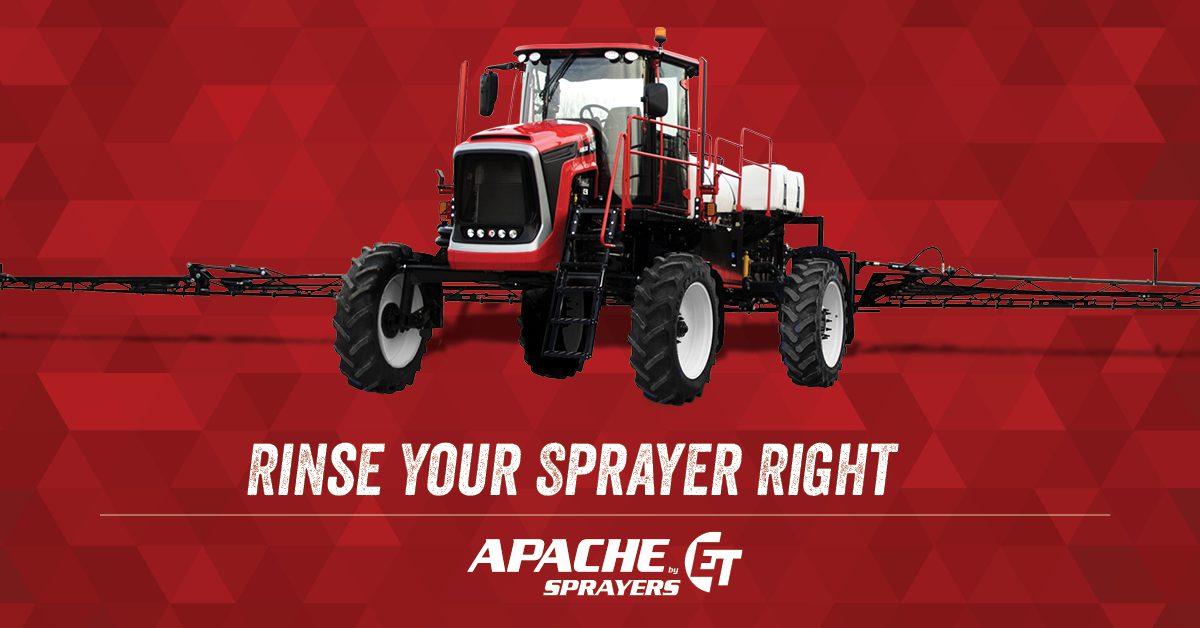Are you getting the most from the chemicals you’re spraying? Part of the answer to that question lies in how well you maintain your sprayer between applications. A properly cleaned and rinsed sprayer system not only helps keep your machine in top operating condition, but also prevent crop damage that can cut yields and add to overall costs.
“Everybody has made mistakes when they haven’t gotten things rinsed out well enough,” said ET Works Senior Application Specialist Jeremy Hurt. “Chemicals and crop input costs right now are really expensive, so it’s not bad to be self-conscious about doing it right. I think Apache Sprayers make this process much easier to do. It’s not as time-consuming and doesn’t involve as many steps.”
How to Clean Your Herbicide Sprayer
- Use clean water to flush the tank, hoses, the boom, and each nozzle.
- Prepare your cleaning solution: 20 gallons of water, 1 gallon of household ammonia, and 1 gallon of Simple Green or commercial tank cleaner of your choise.
- Thoroughly and carefully use a pressure washer to apply this cleaning solution.
- Keep an eye on strainer clogging.
- Take your time and rinse carefully.
- Rinse in the same field you sprayed in.
More Tips for Ag Sprayer Rinsing
1. Get acquainted with the machine
The process starts by familiarizing yourself with your sprayer’s rinsing components and by using the correct tools to do an effective job. Most Apache Sprayers are equipped with 100-gallon rinse tanks, and the amount of water used during rinsing depends on what chemical you’ll apply next, and how long it will be before the next field operation.
“If you are done spraying and want to clean out your machine and resume spraying the same chemical a short time later, but don’t want the chemical sitting in the sprayer for two or three days, rinsing with 50 gallons will be adequate to clean things out,” Hurt said. “If you’re going to go from spraying corn today to soybeans tomorrow, you’re going to want to use the full 100 gallons and rinse everything twice. You don’t want to risk applying small amounts of the wrong herbicide to the wrong crop.”
2. Take advantage of tools available
In rinsing your sprayer tanks, make sure you’re taking advantage of all the tools and hardware on the machine to do an adequate job. Apache Sprayers, for example, feature Roto Flush nozzles inside the main tank that make better use of the onboard rinsing tank on many models.
“The nozzles mount to the top of the tank and, as you’re rinsing out, you send your rinse water through the nozzles to rinse the inside of the tank from the top down,” Hurt said, adding the Roto Flush system has been standard equipment on Apache Sprayers for the last six years.
3. Rinse everything thoroughly–and we mean everything
It’s critical to make sure you’re effectively rinsing all components that have encountered chemical. It’s a common mistake to overlook parts like the chemical inductor and some boom sections. It’s important to also open end caps so that clean water reaches every boom section and exits the boom ends to prevent the any chemical or herbicide residue from accumulating.
“Chemical will tend to ‘clump’ if it sits. “We use a Hypro Express end cap that allows the operator to pull the cap off simply by removing a pin.”
4. Keep an eye on strainer clogging
Nozzles typically don’t cause many problems, as they “will pretty much clean themselves out” during rinsing, but strainers are a different story. With booms managed in sections, there’s a strainer for each boom section, and it’s at the strainers where clogging is sometimes more likely to occur.
“Especially when going from one crop to another, it’s a good idea to clean strainers separately in case any of them are clogged,” Hurt said. “If you have a clogged strainer, you can tell by the effects on spraying pressure. If you have one clogged nozzle, you probably won’t see that.”
5. Take your time
If you’re using the full 100 gallons from the sprayer’s onboard tank to rinse the whole system, the process should take well over an hour, Hurt said. A partial, 50-gallon rinse should take around 30 to 40 minutes. But, every operation is different, and it’s more important to do a thorough job and do so in a timely manner, all the while being attentive to handling the job safely for both the operator and the surrounding environment.
6. Rinse in the same field you sprayed in
In addition to concerns about overall crop input costs, cross-contamination of chemicals is another problem associated with insufficient sprayer rinsing. Applying even trace amounts of the wrong herbicide can damage crops and lower overall yield potential. That’s why it’s not only important to thoroughly rinse sprayer components, but also do so in the same field where the chemical was applied.
“Rinsing out a sprayer should be done in the field where you sprayed,” Hurt said. “You want to do everything to minimize the chances of chemical contamination.”
Get more tips on sprayer maintenance with the Apache Shop Series.



